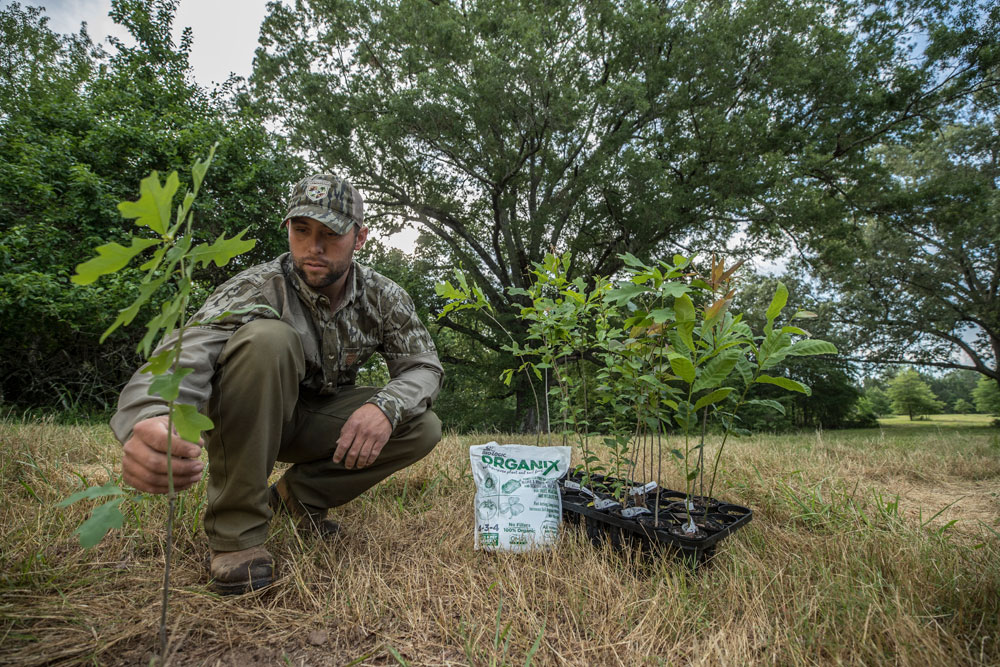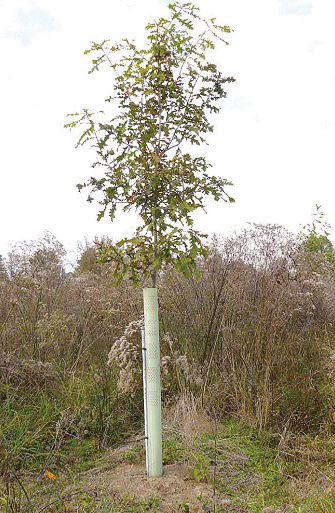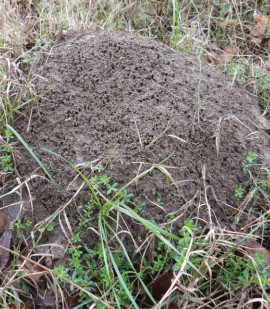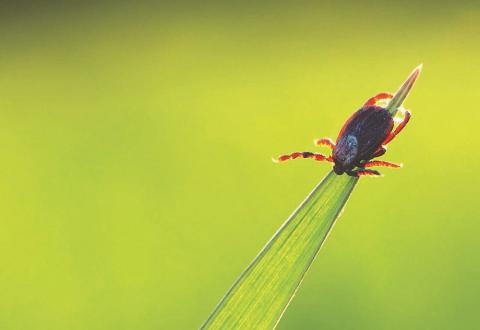Dudley Phelps | Originally published in GameKeepers: Farming for Wildlife Magazine. To subscribe, click here.

In an award winning commercial that began airing on the Pursuit channel a couple of years back, “everyone’s friend” and Mossy Oak mainstay, Mr. Fox Haas, is seen planting acorns and tending to things at Nativ Nurseries with his family. Two of Mr. Fox’s quotes, in his powerful yet eloquent Southern gentleman dialect, stand out that will forever be engrained in my mind are: 1) “I believe, it’s important to take care of the things that we love” and 2) “ I believe, the good that men can do will live long after they’re gone.” If you haven’t seen it, you should.
Although at first the piece seemed to be alluding to the new nursery we were about to open, or even land stewardship/conservation and tree planting in general, but it was far deeper than that. It was more about “good people growth” than plants or animals, but it really encompassed both aspects. The allusions to roots and growth refers to both family and planting trees, or setting the tone for a healthy family lifestyle by sharing time in the outdoors of course…and no one could have said it better than Mr. Fox!
References to this television piece are important because my main point with this article is to hand off some knowledge about growing and taking care of mighty oaks (and other species) in a way that you can enjoy them long before your grand-kids get a chance to do the same. Likewise, if you’re “up-there” in terms of age, you can read this and be assured it’s never too late to plant a tree. By following these tips you’re about to read you’ll quickly learn how much fun and rewarding growing trees can be- even before they begin producing a crop.

properly prepped and maintained Rapid Mast
seedling. This poorly drained clay site was
bedded or “hipped up” 3 months prior to planting.
Note the weed free environment that deters
rodents and saves precious water and nutrients
for the tree.
A Comparison
I’ll begin by saying that traditional planting methods with bare-root seedlings work fine, and they are still the most efficient and economical method for planting large acreages of timber, but if incredibly fast growth with acorn, fruit, and/or mast production at a young age is your goal then the rapid mast seedlings are the way to go.
Our rapid mast seedlings can provide incredible growth rates and fast mast production, but the real key lies in what you do before your box of seedlings comes in the mail. “Site preparation” (site prep) refers to the treatments one performs in advance of planting that can mean the difference between average survival and average growth to absolutely unheard of phenomenal production. So a little extra time spent before, during and after you plant can mean the difference after two growing seasons of between ten foot tall, branched trees with 100 percent survival and four foot tall (at best), hardly branched saplings with a variable survival rate. Site prep, improved planting methods, and aftercare can also greatly influence the growth and survival of our bare-root stock as well, but without an advanced root system it may take an extra year or two before they really start to take off, so keep that in mind before placing your tree order.
Prep-work
Assuming most of you have grown veggies in a garden before, you know how important it is to plant into a deep, loose, well aerated and drained seedbed. I seemed to have learned the hard way moving from rental to rental in my college days. I’d find a spot in the new yard, till the ground and plant all in the same day and never have very good results. So after a few years of poor crops and taking mental notes from folks with successful gardens, I learned to break ground before fall arrived and grow a cover crop of greens. The following spring after terminating the greens my soil would be so perfect that I could use a kitchen knife to dibble the little tomato starts into the ground, and boy was the growth and yield better! Similar techniques can be applied to tree plantings with incredible growth- even in year one. If you wouldn’t plant a tomato start into tight, heavy, chunky soil without advanced preparation, how come folks do it all the time with their tree seedlings? If you want incredible growth beginning with year one, the most important step is to ensure your seedlings are placed into a prime rooting environment.
Here are some general steps to follow:
1. Install pin flags or some other type of markers at your chosen spacing and spray a 3-5 foot circle around each flag with a non-selective herbicide such as glyphosate. In lieu of herbicides you can lay down mulch, scrap plywood, or anything that will block sunlight to terminate the existing plant growth. After a couple of weeks the weeds/grasses and their roots should be dead, making step 2 much easier.
2. Dig a wide and deep planting hole then immediately refill the planting hole with the soil you just removed. After this is complete, dig a circle immediately around your hole and place that soil on the pile. When you’re done, the site should look like a cloddy, small pitcher’s mound with a moat around it. During this step you can also incorporate amendments such as a handful of fertilizer and/or a generous amount of composted manure. I don’t recommend incorporating anything that will drastically change the physical structure of the soil including sand, bark, or potting soil. Depending on your soil type you should wait AT LEAST a month, or for a couple of rain events before moving on to step 3 (planting day). With heavy clays and other “difficult” soils, you may need to wait 2-4 months. While waiting for step 3, I generally allow weeds to grow on the planting site or even plant some food plot seeds to help mellow and improve the soil while waiting. At least a couple of weeks before step 3, terminate the weeds once again to facilitate digging and reduce competition with your seedling’s roots.
3. Since you’ve already done all of the prep-work, and your planting spots are like miniature raised beds of easily workable soil, planting day is a breeze and the most fun step. I often forget things, and forgetting your shovel on planting day is no longer a problem- a sharpened stick or piece of rebar can be used to make an opening large enough for your rapid mast seedlings because of the prep work you’ve done. Plant each seedling level with the soil surface, drive a stake, and install vented tree tubes 1/2” deep. Our favorite tube system by far is the Tubex Combitubes, paired with sturdy and flexible PVC conduit pipe as the stake. At this point I’ll dibble a couple of BioLogic Tree-Paks (includes N-P-K and micros) or a tablespoon of granular fertilizer such as 13-13-13 roughly 4-6 inches from the root-ball. If fire ants are a concern in your area, spread the labeled rate of bifenthrin (trade name Talstar or its generic) to keep them away from your seedling and tube. If planting when the seedlings are not dormant, go ahead and water thoroughly by pouring water directly down and around the tube for a good slow soak.

shovel necessary. Just treat the ant bed
a couple of weeks in advance to
terminate the ants, and voila- a perfectly
prepped raised bed of tilthy goodness
awaits your seedling and a tree
protector.
On a Larger Scale
The prep work described above refers more to folks using simple hand tools and elbow grease, but these same site prep treatments can be performed on a larger scale with implements such as sub-soilers, bedder/hippers/row-builders or even augers. On the subject of augers, known as a “posthole digger” to many, keep in mind the spinning action of the auger bit can glaze, or smear and harden the edge of the dug hole, which can deter roots from penetrating out from the planting hole. If using an auger, you must go back with a shovel and “cave in” the edges of the hole while backfilling with soil. Also remember to borrow some soil from the surrounding site, because a good bit of augered soil can stick to the bit or get thrown to the side while the bit is being removed. I’ve seen it time and time again where folks plant immediately into augered holes, and they come back a couple of months later to see the seedlings have sunken a few inches into the ground after the soil has settled. Avoid this by augering in advance, adding borrowed soil to the planting hole while backfilling, and waiting a few weeks for the soil to settle and mellow before planting day.
Perhaps in a near future article I can discuss some advanced maintenance tips on what to do after planting day to improve survival, growth, and yield of your trees. Just like my two favorite Fox Haas quotes, it’s about taking care of trees both before and after they are planted. This will ensure they’ll provide fruits and enjoyment, both before and long after you’re gone.
A site that is “prepped in advance” will allow more time and energy to transplant seedlings, widen your planting season window, drastically improve survival and growth rates, reduce the wait time for mast production, and most importantly - give you that sense of fulfillment from a job well done. If you want to learn more, go to our website www.nativnurseries.com for contact information, links to our library of youtube videos, and postings of successes on our facebook page.




























